
Its that time of year again! This year we will have our own booth at SHOT Show, so you can get your hands on our new slide patterns, as well as our Combat Pistol and MKII rifle line! Booth 4366, hope to see you there!

Its that time of year again! This year we will have our own booth at SHOT Show, so you can get your hands on our new slide patterns, as well as our Combat Pistol and MKII rifle line! Booth 4366, hope to see you there!
For Immediate Release – Swansboro NC –High Speed Gear® and company will be showcasing 8 new products at the Shooting Hunting Outdoor Tradeshow (SHOT) Show in Las Vegas, Nevada, January 22nd-25.
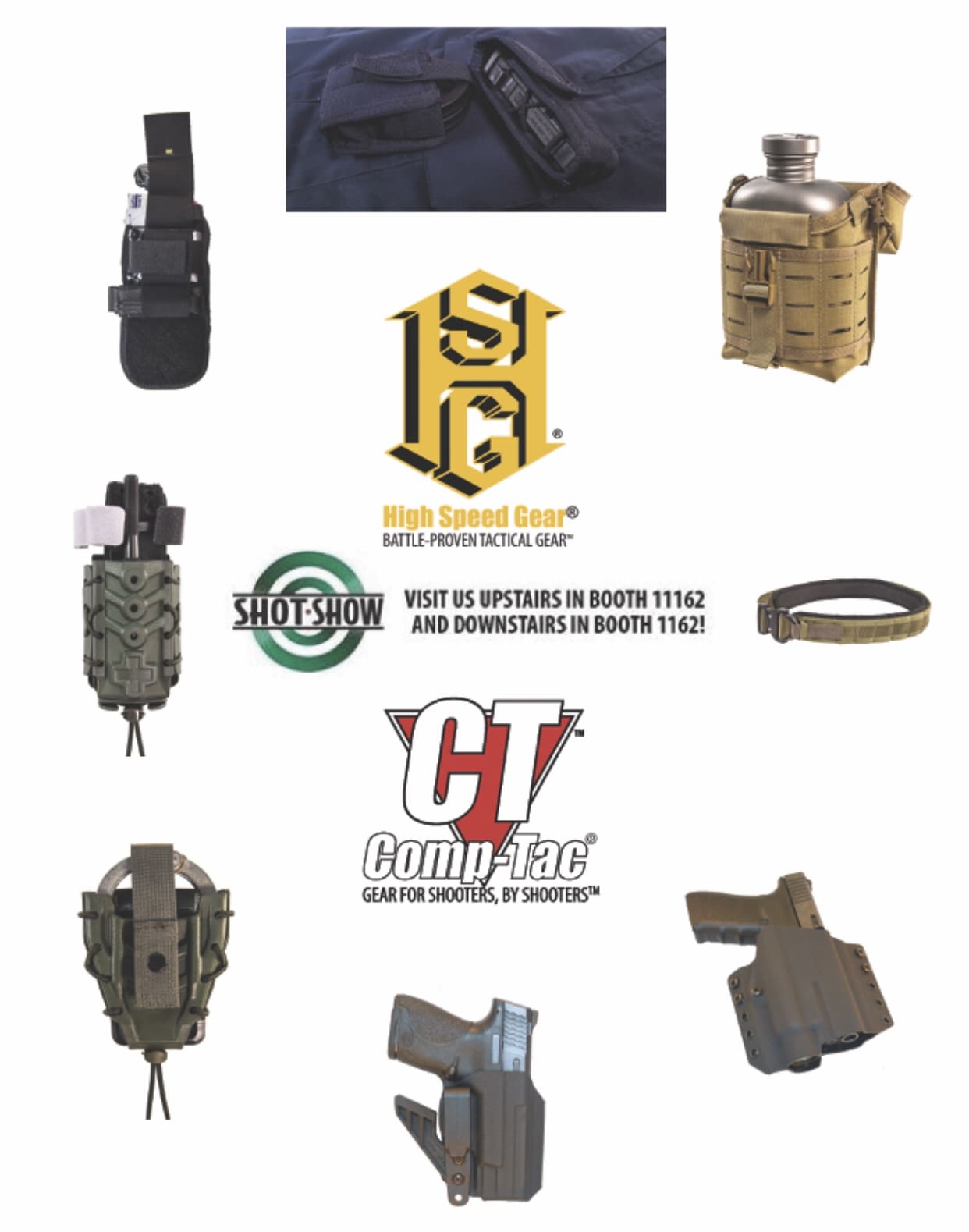
Displaying with Comp-Tac®, HSGI® and company will have a variety of products incorporating all customer groups to include; eV2 appendix holster and light bearing Warrior™ holster, Operator COBRA® belt, L.E. Blue Duty Gear, Kydex® Handcuff and Tourniquet TACO®s and a 247 Trauma ankle med wrap.
eV2™ AIWB Holster- The eV2™ is an inside the waistband holster deisgned for appendix carry. With the Comp-Tac Kick attachment this holster is the ultimate for deep concealment riding close into the body, grip and all.
Operator COBRA® 1.75” IDR Belt- A two belt system, The Operator COBRA® IDR 1.75” Rigger Belt is a low-profile shooter’s belt designed to work with both MOLLE and belt-mounted gear.
Kydex® Handcuff TACO®- Combining Kydex® and HSGI’s versatile TACO® design this handcuff holder will work with multiple size handcuffs while maintaining the look and functionality of other HSGI products.
L.E. Blue Duty Gear- The HSGI® Duty Line of products functions the same as the originals, but feature a sleeker front and hidden bungee, which is woven internally. Now available in the deep L.E. Blue this is an option for even more departments and agencies.
Kydex® Tourniquet TACO®- With a myriad of Tourniquet sizes and style on the market how do you hold them all securely and still effectively? The Kydex® and shockcord combination allow it to be done!
Canteen 1QT Pouch- This pouch is designed to fit one-quart canteens, such as standard-issue USGI canteens, as well as other items like stoves, MRE’s or multiple rifle magazines.
Warrior™ with Light Holster – The popular Warrior™ holster now includes even more light and firearm combinations with the additional upgrade of size adjustable HSGI® belt mounting clips.
247 Trauma Wrap – With 5 pockets and a neoprene pad / anti-slip guard, this medical ankle wrap is designed to carry essential supplies to stabilize a gunshot wound.
“For the past few months our teams, at both our Swansboro and Houston locations, have been working hard developing new products for all our customers. To kick off 2019, we are releasing 8 new products suited for the LE, MIL, Sport Shooter and Responsibly Armed Citizens. They, along with our full line of products, will be on display next week at Shot; and we are looking forward to seeing the reaction of our customers,” stated Bill Babboni VP of Sales and Operations. “These 8 products are just the beginning. With an additional new 11,000 square foot shipping facility opening in Swansboro this February and additional equipment and staff being deployed in Houston, the sky is the limit for what we will bring our customers in 2019.”
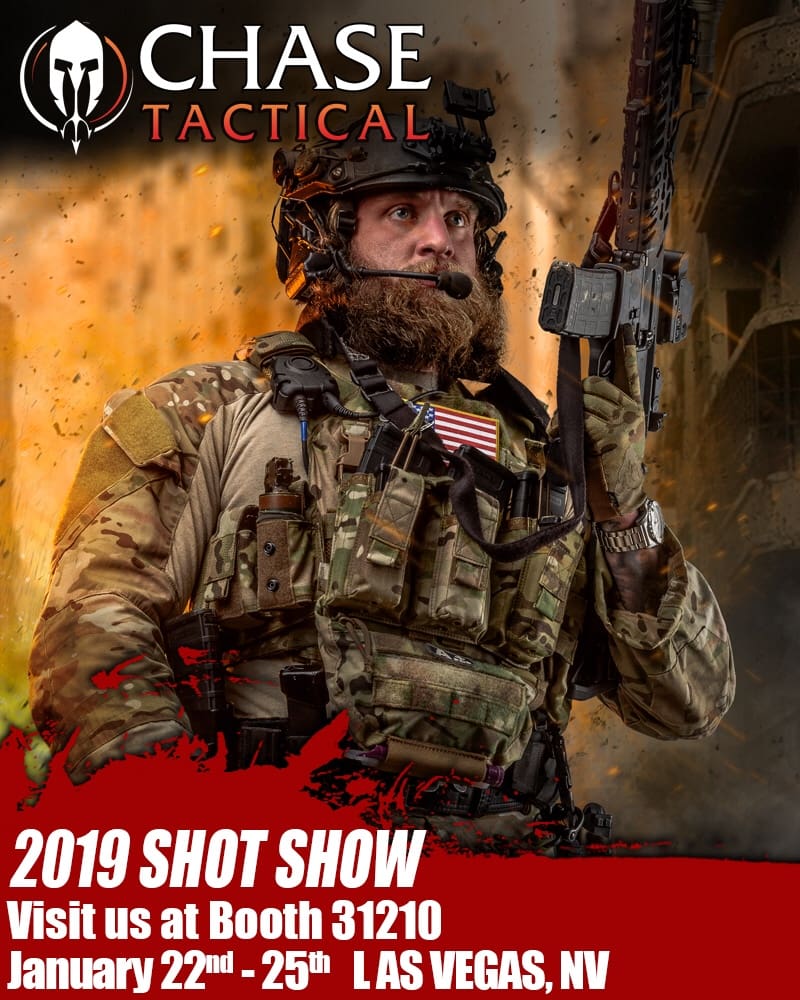
Chase Tactical will be exhibiting at the 2019 SHOT Show. We’ll be located in Booth 31210 where we’ll have our new product line along with our Ballistic Armor product line. If you would like to set up a meeting with Chase Tactical we can be contacted at Sales@ChaseTactical.com
A-TACS Camo in partnership with TRU-SPEC introduce new uniform style with a deep connection to the history of SOCOM–paired exclusively with A-TACS Camo, the ultimate concealment solution.
Since the inception of modern Special Forces groups in the early 1950s, it was commonplace for many of them to modify the uniforms they wore to better suit the specifics of their mission criteria.
In keeping with that tradition at the beginning of the Global War On Terrorism, Special Forces groups began a new series of modifications to their existing Battle Dress and Desert Combat Uniforms. Chest and arm pockets were modified to enable easier access when wearing protective or load bearing gear as well as additional modifications required to make it easier to remove identifiable personal and unit information as needed. Noisy Velcro closures were replaced with buttons for stealth and easier repair in the field. A simpler, less restrictive uniform cut also made the uniforms more adaptable to rapidly changing mission objectives.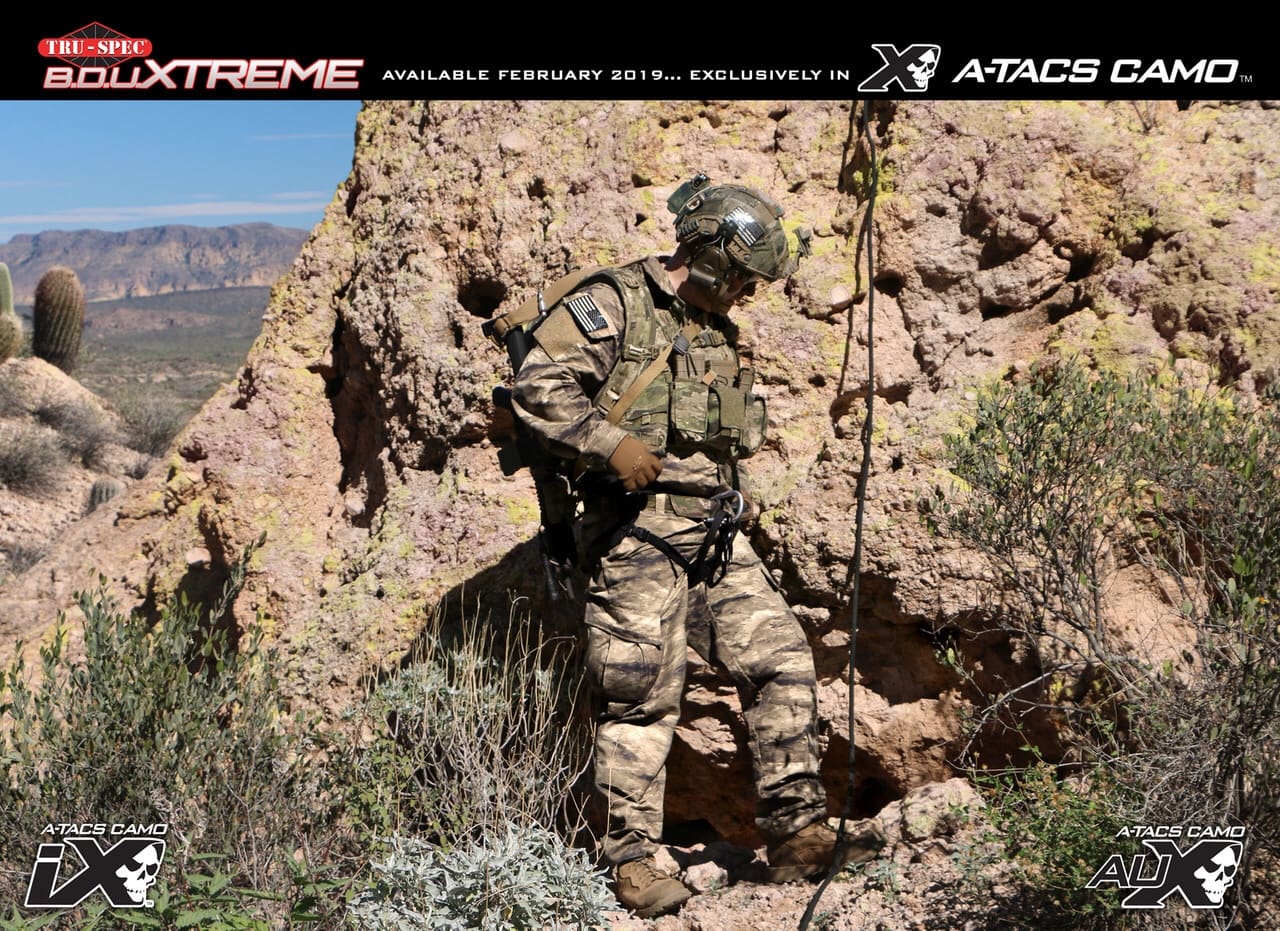
The new TRUSPEC BDU Xtreme (BDU-X) was developed in partnership with A-TACS Camo and was created with the input of Special Operations and Law Enforcement personnel. It is a hybrid uniform design and bridges the gap between the original BDU and the modern ACU uniform by incorporating many of the best features of both. Cut from soft yet durable 50/50 Vat Dyed NyCo that resists fading and shrinking these uniforms are built to perform.
Features:
-50/50 Vat-dyed colorfast NyCo ripstop for moisture wicking and breathability
-NIR Management built in to each garment
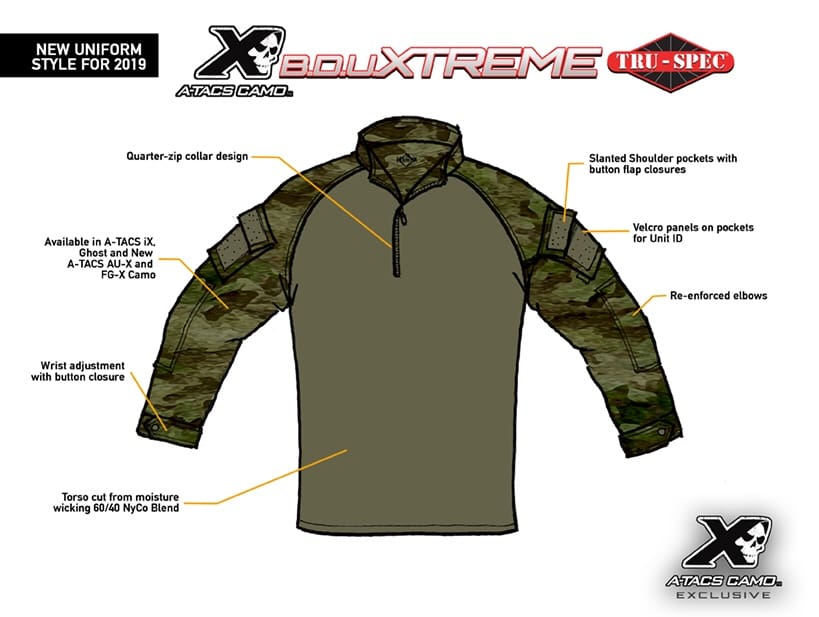
BDU-X Top Features:
-Slanted Shoulder pockets with button flap closures
-Velcro panels on pockets for Unit ID
-Two slanted upper chest pockets with button closures
-Front button closure
-Re-enforced elbows
-BDU style collar
-Wrist adjustment with button closure
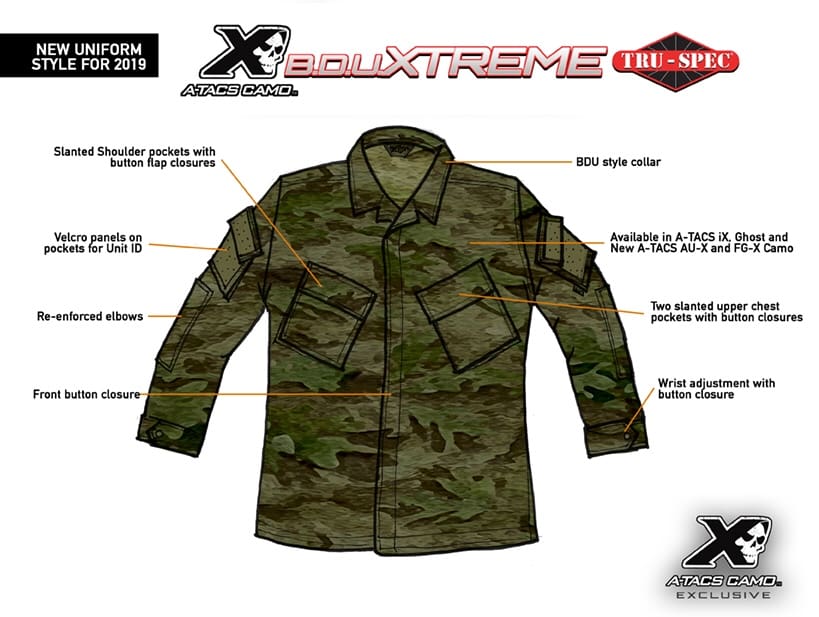
BDU-X Combat Shirt Features:
-Slanted Shoulder pockets with button flap closures
-Velcro panels on pockets for Unit ID
-Torso cut from moisture wicking NyCo Blend
-Wrist adjustment with button closure
-Re-enforced elbows
-Quarter-zip collar design

BDU-X Pant Features:
-Two slanted cargo pockets with button flap closures
-Two rear pockets with button flap closures
-Two side slash pockets
-Oversized belt loops
-Front button closure
-Re-enforced knees and seat
-Blousing strings for adjustment at base of legs
A-TACS Camo…The Ultimate Concealment Solution–Enhanced
These new uniforms are available exclusively in the complete “X” series of camouflage patterns from A-TACS Camo, including New A-TACS AU-X and FG-X along with A-TACS iX and Ghost. Like the BDU-Xtreme, the “X” series of A-TACS Camo patterns was developed with the input of Special Operations personnel.
Mixing and matching camouflage patterns has also been an effective strategy for Special Operations throughout their long history of service. It is with that understanding that the new A-TACS AU-X and FG-X camo patterns along with A-TACS iX , are designed to mixed and matched with one another to further break the human silhouette for maximum levels of concealment in a wide variety of environments.
The “X” series of patterns utilize a shared common color palette with the ratio of brown and green tones altered between each of the respective patterns. This enables the end user to pair one set of Nylon Gear in the A-TACS iX (intermediate) pattern with either the FG-X (tropical), the AU-X (arid), or to utilize the iX pattern from head-to-toe in transitional terrain to easily maintain effective levels of concealment without changing over expensive nylon gear.
Simply put, the A-TACS Camo X Series is a complete concealment solution with infinite adaptability.
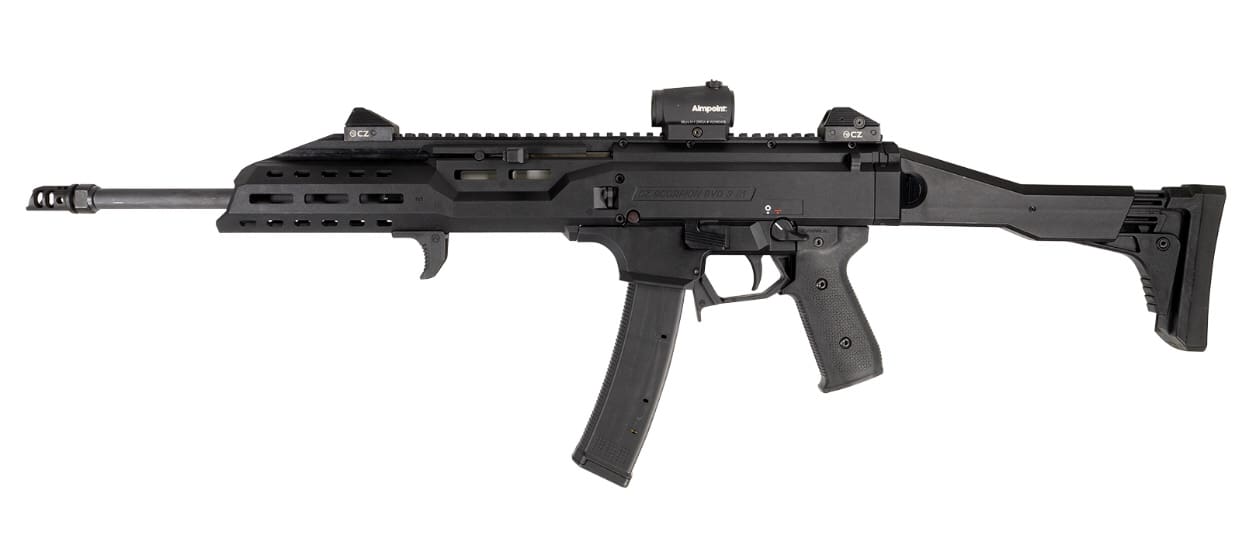
Like many of you, I own a Scorpion and now I’m looking forward to updating some of the parts on my gun as well as magazines, with these new accessories from Magpul.
Magpul® MOE®-EVO Grip
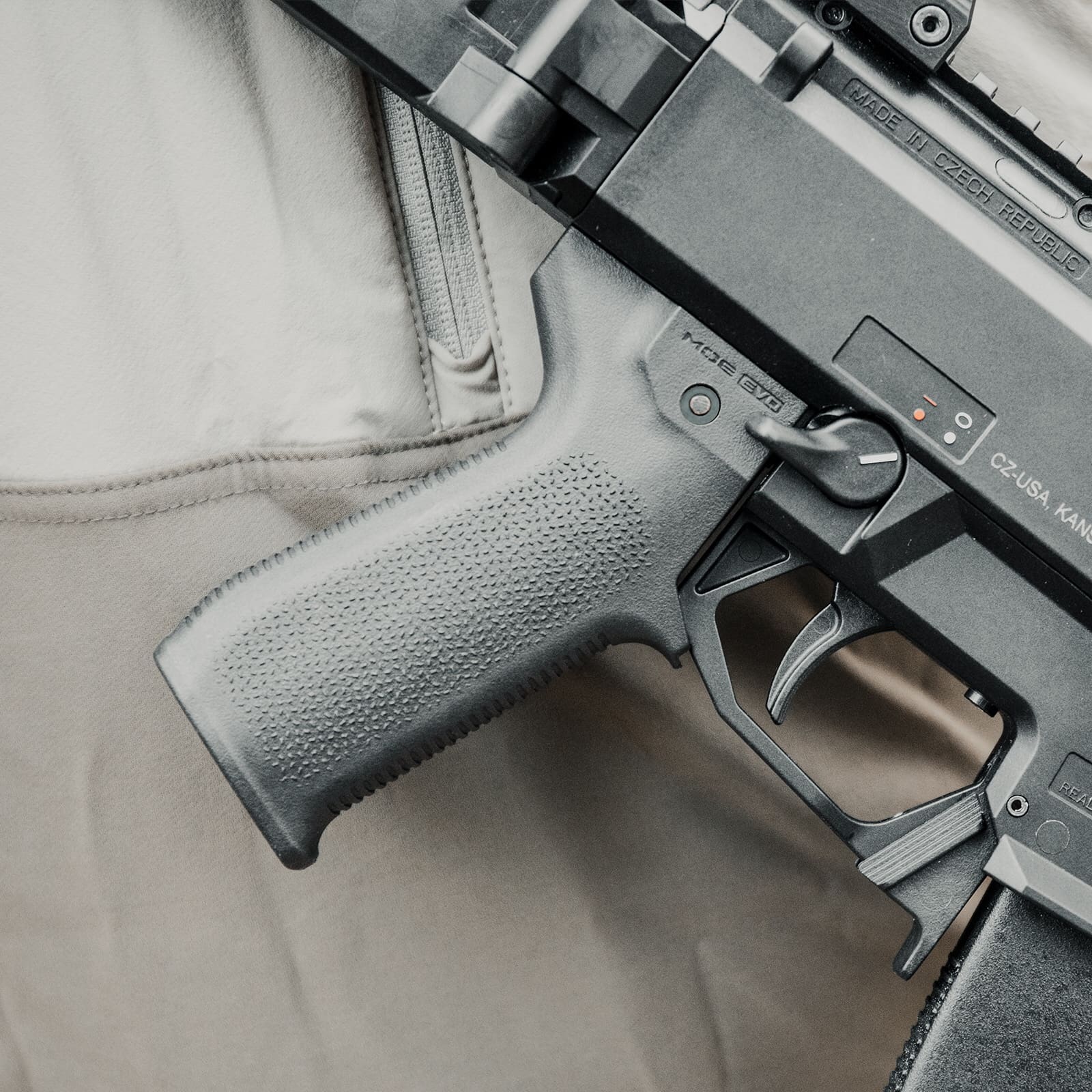
The Magpul MOE-EVO Grip is an optimized drop-in upgrade to the CZ Scorpion EVO 3 family of pistols and carbines. Featuring an enhanced grip angle and Magpul’s proprietary TSP texture on contact surfaces, the MOE-EVO Grip gives users unsurpassed comfort, control, and durability. This lightweight and ergonomic grip builds on the legacy of Magpul’s MOE AR and AK grips to provide CZ Scorpion EVO 3 users positive control in all conditions, with or without gloves.
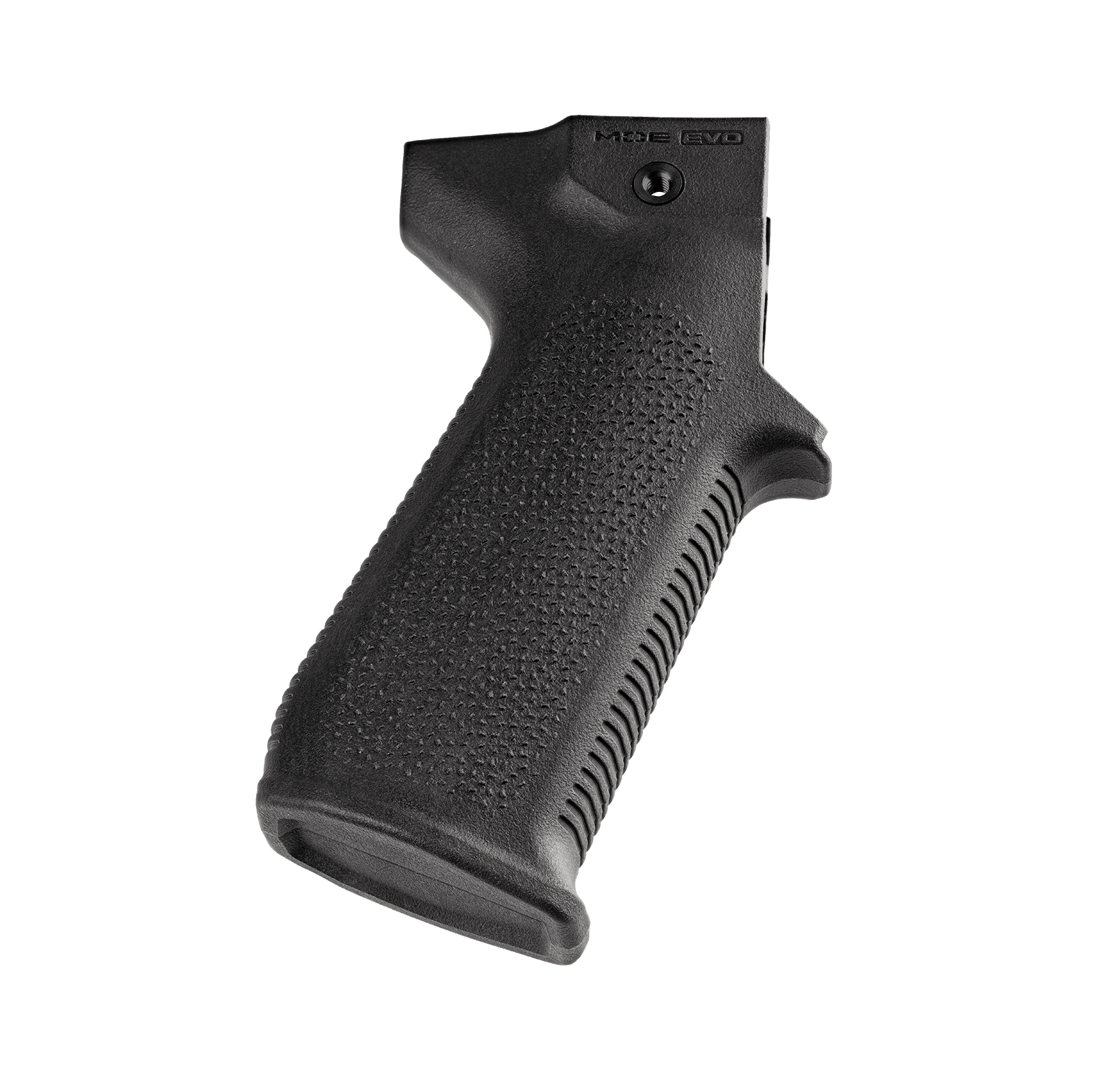
Features:
· Optimized grip angle allows enhanced control with short LOP stocks and pistol configurations, with and without a brace
· Aggressive TSP grip texture increases weapon retention in all environments and is substantially more durable than grip tape
· Ergonomic design mitigates fatigue and ensures ease of access to weapon controls while maintaining a secure grip
· High-strength injection-molded polymer construction
· Easily installs with a 3mm hex wrench
· Made in U.S.A., qualifying as one U.S.-made part for 922(r) compliance
Colors BLK
MSRP $24.95
Magpul® MOE®-EVO Enhanced Magazine Release
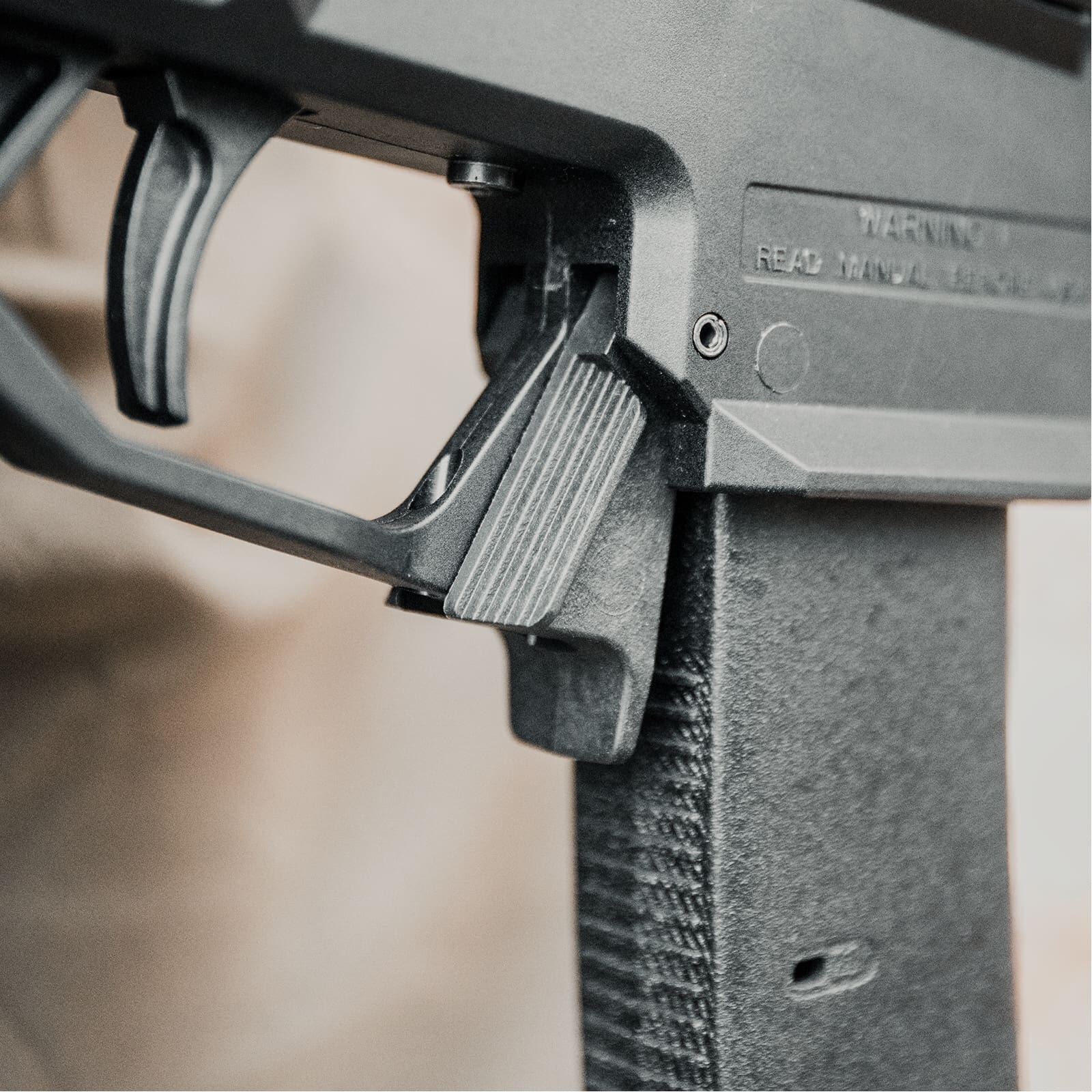
The Magpul MOE-EVO Enhanced Magazine Release includes advanced interface geometries and surface texture on the paddle and wings to allow easy, one-handed activation and magazine removal, while still remaining unobtrusive. It lets the shooter easily release the magazine and is accessible with the firing-hand index finger or the reloading-hand thumb.
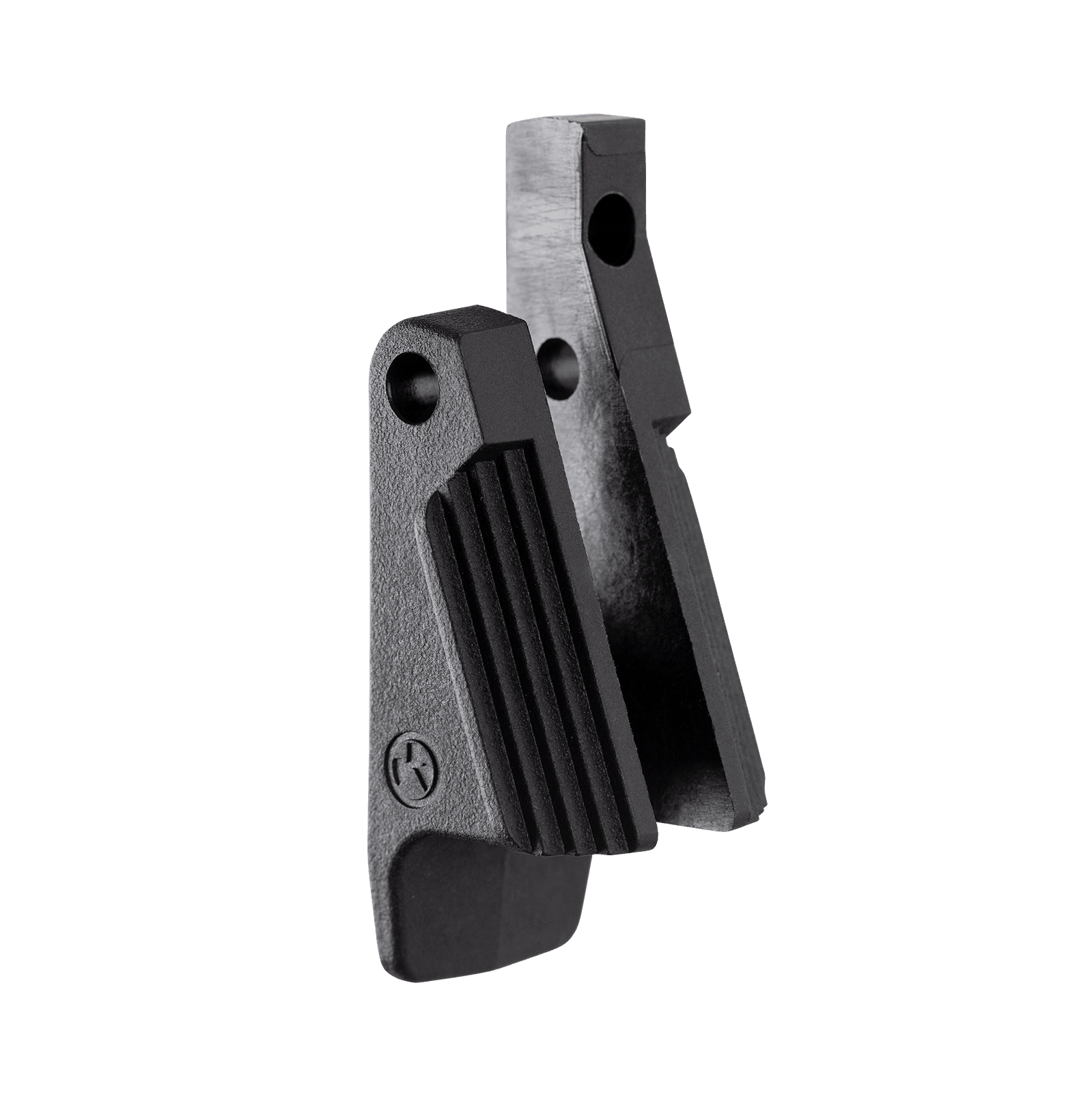
The Magpul MOE-EVO Enhanced Magazine Release is a reliable, durable, and affordable drop-in upgrade to the CZ Scorpion EVO 3 family of pistols and carbines. The paddle design allows for easy, one-handed activation and magazine extraction, maximizing economy of movement.
Features:
• Increased surface area allows for better purchase and positive release activation while remaining low-profile
• Textured ridges and an easy-to-reach paddle allow ambidextrous use, with or without gloves
• Optimized lever angle for positive activation Durable, lightweight, high-strength polymer construction
• Installs easily with a 5/32″roll pin punch
Colors BLK
MSRP $24.95
Magpul® PMAG® 35 EV9™
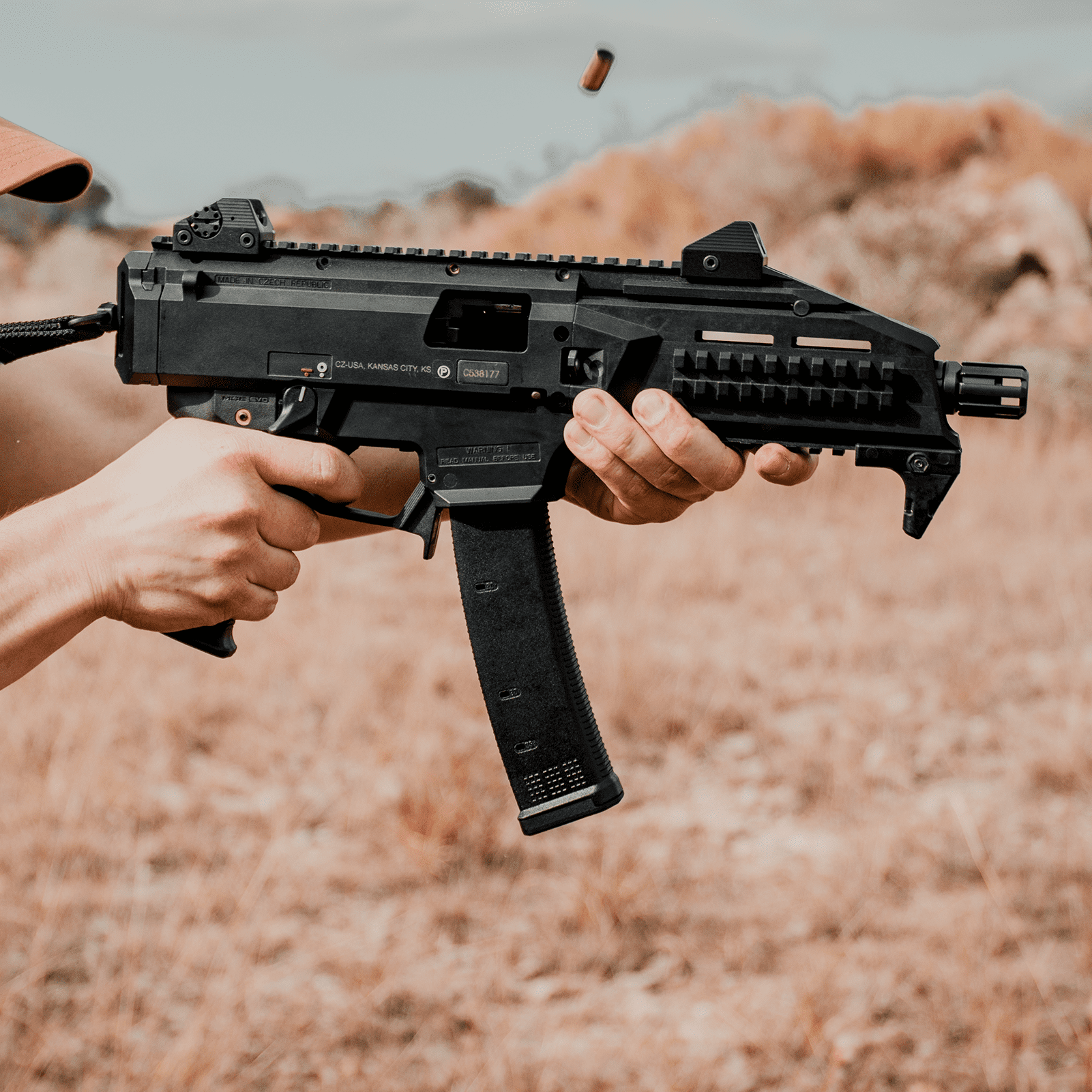
The PMAG 35 EV9 is a lightweight, 35-round, 9x19mm CZ Scorpion EVO 3-compatible magazine. The PMAG 35 EV9 provides optimal round stack geometry, giving the large format pistol, PCC, and SMG market Magpul reliability and increased magazine capacity in a pistol caliber magazine. Features include advanced impact-resistant polymer construction, an easy to disassemble design, and a highly impact-resistant floor plate. Additionally, the PMAG 35 EV9 features a rounds remaining capability in the form of capacity indicator windows at 10, 20, 30, and 35-round intervals. A Paint Pen Dot Matrix is provided for magazine identification, and the ridged front and back strap on the magazine body provides a secure grip in all environmental conditions. The PMAG 35 EV9 provides the CZ Scorpion EVO 3 owner the design, reliability and durability expected from Magpul, all at a competitive price point.
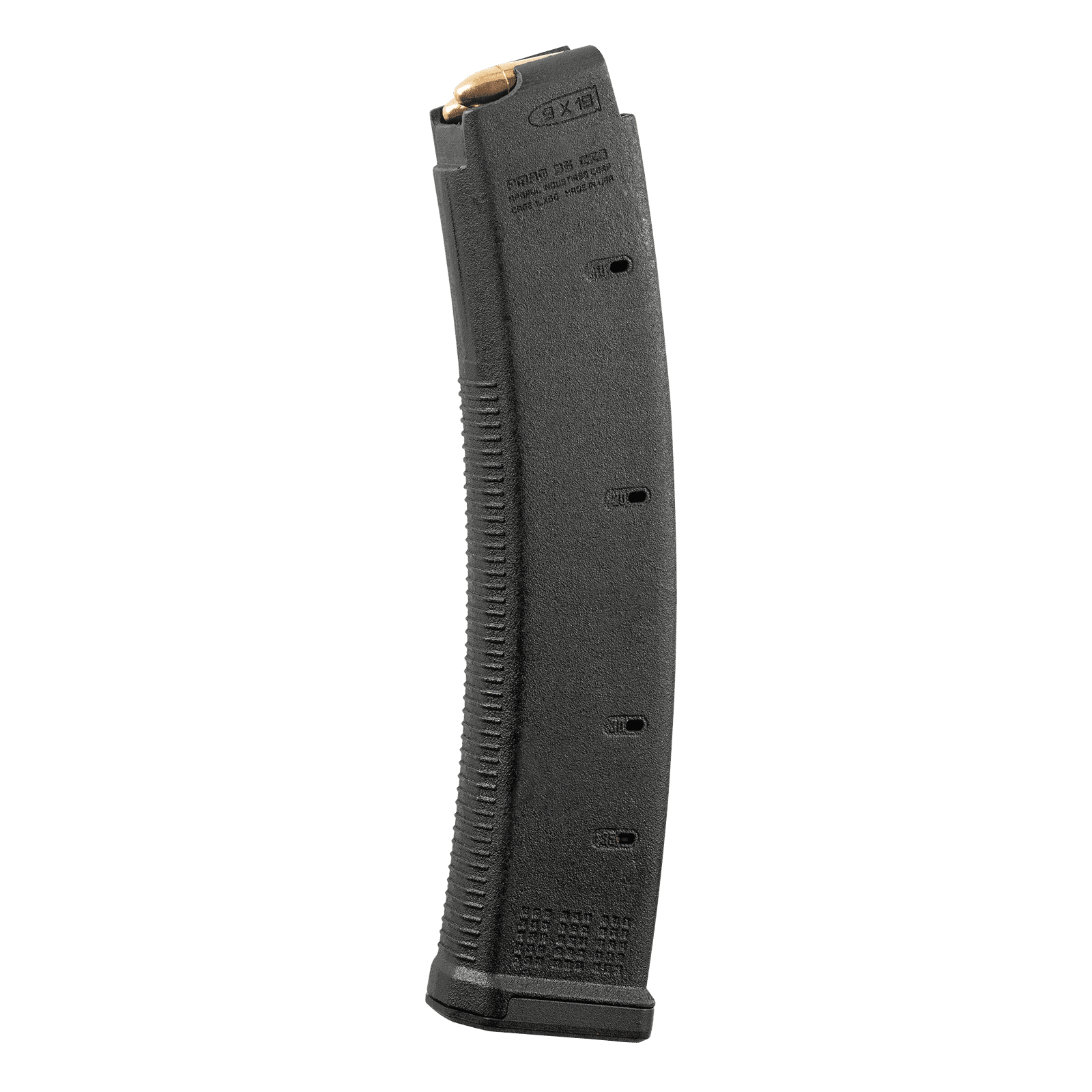
Features:
· 35-Round Capacity with capacity indicator windows at 10, 20, 30, and 35-round intervals
Easy to disassemble design for cleaning
· High visibility follower
· Advanced impact resistant polymer construction
· Long life stainless steel spring for corrosion resistance
· Highly impact-resistant floor plate
· Paint Pen Dot Matrix for magazine identification
Made in the U.S.A., qualifying as one U.S.-made part for 922(r) compliance
Colors BLK
MSRP $19.95

Comer, Ga. (January 2019) – MasterPiece Arms (MPA), manufacturers of the MPA BA Rifles and Chassis Systems, will unveil its new MPA BA Enhanced Sniper Rifle (ESR) Chassis in booth 2716 at SHOT Show 2019, to be held at the Sands Expo Center in Las Vegas, Nevada, Jan. 22 – 25, 2019. This is an enhanced version of MPA’s highly successful BA Chassis System and was designed as a submission for a recent military program, meeting the chassis specifications as required. The MPA BA ESR Chassis offers functionality in military, law enforcement and various competitive shooting applications.
The MPA BA ESR Chassis enhancements include M-Lok slots along the sides and bottom of the chassis forend, an enhanced night vision bridge option and an additional two inches of length to the forend. The chassis is machined on MPA’s CNC Horizontal Machining Centers to exacting tolerances from 6061 aluminum. The v-bedding system provides additional clearance for glass bedding action and straight section of the barrel, if desired. The chassis also includes a built-in inclinometer leveling system, machined thumb notch and V4 Spigot Mount (Picatinny Rail and Dovetail Plate built in). There are multiple QD sling swivel locations and the unique pocketing system reduces weight and increases structural integrity of the chassis. The MPA Buttstock comes with an adjustable cheek riser, length of pull and bag rider. The chassis also comes equipped with a two round holder.
This unique chassis system provides a super precision platform for the Remington 700 Short and Long, Savage and Howa Short or Long Actions, Tikka, Badger M2013, Mausingfield, Surgeon, Stillers and many others. Multiple colors are available for the Cerakote® finish, including Graphite Black, Flat Dark Earth, Burnt Bronze, Tungsten, Gunmetal, Sniper Green, NRA Blue and USMC Red.
MPA BA ESR Chassis Specifications:
Chassis Weight: 5.4 lbs.
Coating: Cerakote
Length of Pull: 13.5 – 14.75” (can be reduced to 12.5” upon request. Additional fee may apply.)
Magazine: Any AICS Type (magazine not included)
MSRP: $1,000 – $1,400
MPA makes every effort to get the product to the customer as quickly as possible. These are hand-built precision instruments and not production components. To see MPA’s latest delivery and lead times for all Bolt Action Rifles and Chassis, visit masterpiecearms.com/bolt-action-rifle-and-chassis-current-delivery-times.
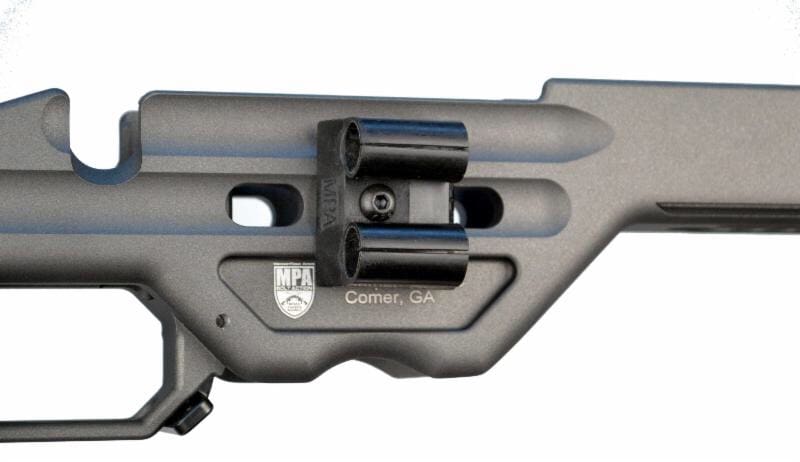
For more information on MasterPiece Arms and their product line of rifles, chassis systems and accessories, visit www.masterpiecearms.com.

SPRINGFIELD, Mass., January 12, 2018 — American Outdoor Brands Corporation (NASDAQ Global Select: AOBC), one of the world’s leading providers of firearms and quality products for the shooting, hunting, and rugged outdoor enthusiast, today announced that its Electro-Optics Division, Crimson Trace Corp., has completed the purchase of substantially all of the assets of LaserLyte, a provider of laser training and sighting products for the consumer market.
Lane Tobiassen, President of the Electro-Optics Division and Crimson Trace Corp., said, “We are excited to add the LaserLyte brand and product lines to our existing lineup of Crimson Trace laser sights, tactical lights, and optics. LaserLyte is well-known among consumers for its innovative laser training and sighting products, which cover a range of applications including non-live fire firearms training, sighting in rifle scopes and optics, and entertainment. LaserLyte’s firearm training systems, laser sights and bore sights complement our existing offering, enabling us to reach broader segments of the consumer electro-optics addressable market. LaserLyte products fit well within our existing distribution network, and with the support of our product development and sourcing teams, we believe the additional brand and product lines provide us with growth and expansion opportunities for the Electro-Optics Division.”
Crimson Trace completed the acquisition of LaserLyte assets, consisting largely of inventory and intellectual property, utilizing cash on hand. Inventory related to the acquisition will be transferred to the Crimson Trace facility in Wilsonville, Oregon, where LaserLyte operations will be assumed by existing product development, sourcing, assembly, and sales and marketing teams.